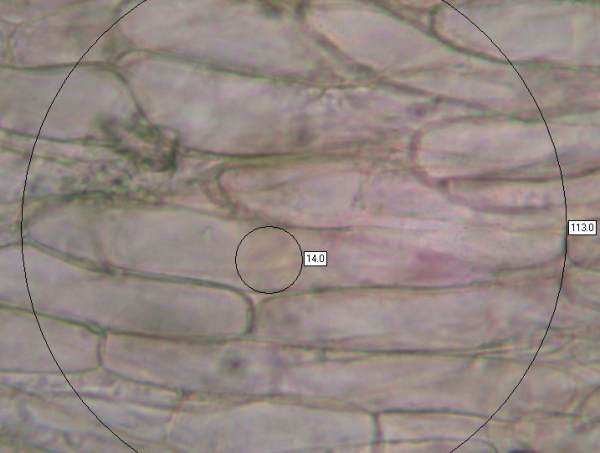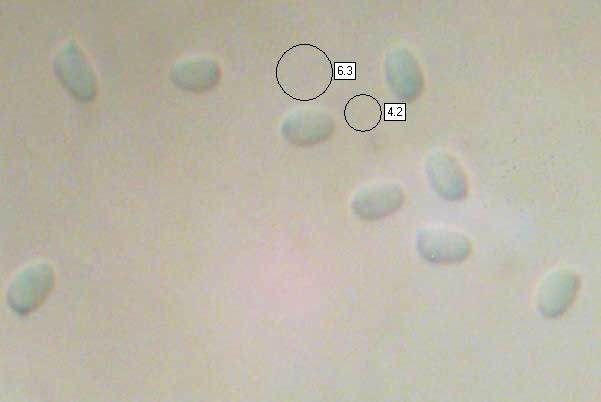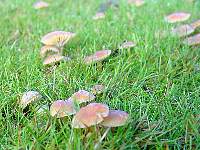Gliophorus laetus (Pers.) P. Kumm. - Heath Waxcap
Phylum: Basidiomycota - Class: Agaricomycetes - Order: Agaricales - Family: Hygrophoraceae
Distribution - Taxonomic History - Etymology - Identification - Culinary Notes - Reference Sources
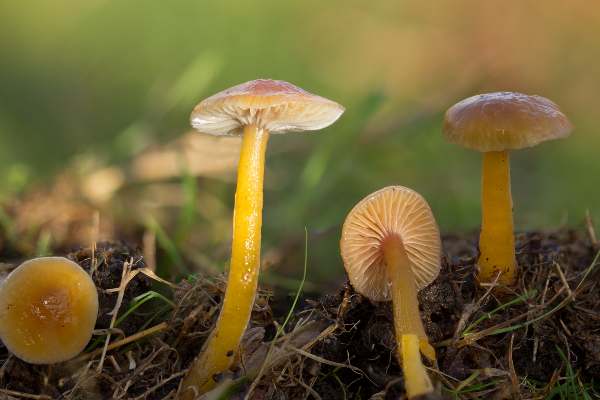
This little orange-brown waxcap is a fairly frequent find on cropped grassland, particularly among mosses on moorland. The cap is markedly striate across two thirds of its diameter.
Heath Waxcaps often occur in quite large clusters in mossy moorland that is continually grazed to a short sward by sheep or ponies. This gregarious little mushroom is one of the few waxcaps that can be identified easily in the field - just look beneath the cap, and you will see why!
Distribution
Uncommon (as nearly all waxcaps are nowadays because of the limited amount of suitable grassland habitat remaining) but far from rare in Britain and Ireland, Gliophorus laetus is also found in many parts of mainland Europe, where the orange form shown here is seen most often in central countries. In Scandinavia a yellow variety becomes increasingly common the further north you go. This waxcap is also found in parts of North America.
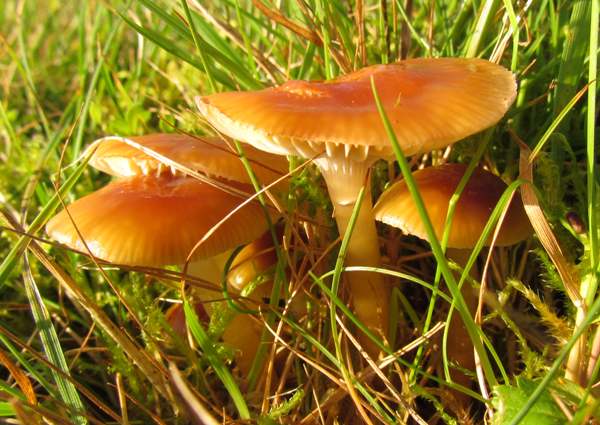
Taxonomic history
When in 1800 Christiaan Hendrik Persoon described this waxcap he gave it the name Agaricus laetus. (In the early days of fungal taxonomy most gilled mushrooms were initially placed in a gigantic Agaricus genus, which has since been slimmed down and most of its content distributed to new genera, including Hygrocybe.) It was the German mycologist Paul Kummer who, in 1871, transferred this species to the genus Hygrocybe, thereby creating its currently accepted scientific name Gliophorus laetus.
There are two varieties of this species in Britain. During the past two centuries or so the nominate form of the Heath Waxcap, Gliophorus laetus var. laeta, has acquired a few synonymous scientific names including Agaricus laetus Pers., Hygrophorus laetus (Pers.) Fr., Gliophorus laetus (Pers.) P. Kumm., and Hygrophorus houghtonii Berk. & Broome.
The other variety of Heath Waxcap is Gliophorus laetus var. flava and was described for the first time in 1995 by Danish waxcap expert David Boertmann. In Britain and Ireland this is a very rare find; it is distinguished by a yellowish cap and yellow rather than grey gills; this variety is more common in the far north of mainland Europe.
Etymology
The genus Gliophorus comes from the from Greek glia-, meaning glue, and the Latin -phorus from the Greek -phoros which means bearing: Gliophorus refers to the glue-like thick liquid that coats the caps, gills and stems of mushrooms in this genus. (Its former genus Hygrocybe is so named because fungi in this group are always very moist: Hygrocybe means 'watery head'.)
The specific epithet laetus means joyful or happy. Well, it is certainly a joy to come across a group of the lovely little waxcaps.
Identification guide
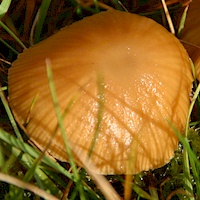 |
CapThe 1.5 to 3.5cm diameter domed cap is orange-brown, hemispherical at first but gradually flattening. Deep striations cover the outer two-thirds of the cap, and the margin becomes slightly toothed with age. |
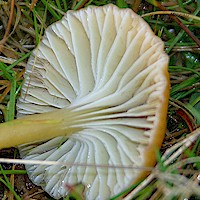 |
GillsAt first pale grey but turning salmon pink as the fruitbody ages, the gills are slightly decurrent. Gill edges are sterile, the spores being produced on the gill faces. StemLevel; 2-4mm diameter and 1.5 to 6cm long, with no stem ring; colour as the cap or slightly paler. |
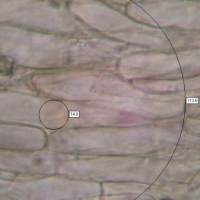 |
Gill tramaSubregular with elements somewhat inflated, up to 130µm long |
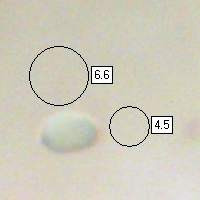 |
SporesEllipsoidal, ovoid or oblong, smooth, 6-7 x 4-4.5µm; inamyloid. Spore printWhite. |
Odour/taste |
Not distinctive. |
Habitat & Ecological role
|
Nearly always in groups rather than as singletons on closely cropped acid grassland where artificial fertilisers are not spread; also on heathland; occasionally on stable sand dunes. Waxcaps have long been considered to be saprobic on the dead roots of grasses and other grassland plants, but it is now considered likely that there is some kind of mutual relationship between waxcaps and mosses. |
Season |
August to November in Britain and Ireland. |
Similar species |
Hygrocybe pratensis is sometimes similar in colour to the Heath Waxcap, but it is a much bigger and more robust waxcap without deep marginal striations. |
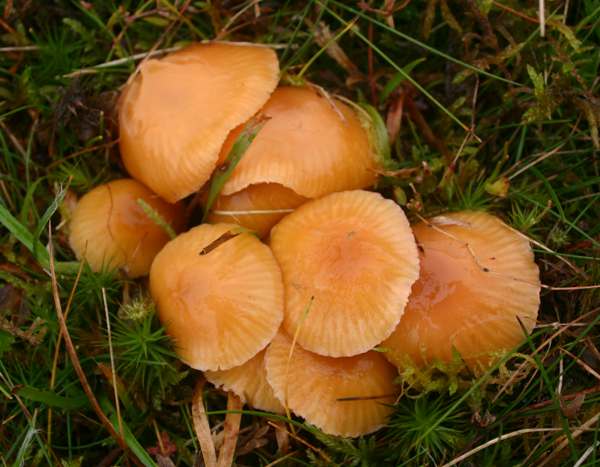
Culinary Notes
The Heath Waxcap is a reasonably common mushroom of acid upland grassland and heathland in Britain and Ireland; however, I have also seen it on hotel lawns no more than 100m above sea level. Its small size makes this species an unattractive species for anyone foraging for fungi to eat.
Often forming tight clumps with up to ten and occasionally more overlapping caps, Gliophorus laetus is therefore quite a conspicuous grassland mushroom despite the modest size of the individual caps.
Although most waxcaps are thought to be edible, some authorities state that the Heath Waxcap is inedible - but in any case who would want to eat these tiny waxcaps rather than enjoy their beauty?
Reference Sources
Fascinated by Fungi, 2nd Edition, Pat O'Reilly 2016, reprinted by Coch-y-bonddu Books in 2022.
Fungi of Northern Europe, Volume 1 - The Genus Hygrocybe, David Boertmann, 2010.
Dictionary of the Fungi; Paul M. Kirk, Paul F. Cannon, David W. Minter and J. A. Stalpers; CABI, 2008
Taxonomic history and synonym information on these pages is drawn from many sources but in particular from the British Mycological Society's GB Checklist of Fungi.
Acknowledgements
This page includes pictures kindly contributed by David Kelly.
Fascinated by Fungi. Back by popular demand, Pat O'Reilly's best-selling 450-page hardback book is available now. The latest second edition was republished with a sparkling new cover design in September 2022 by Coch-y-Bonddu Books. Full details and copies are available from the publisher's online bookshop...
